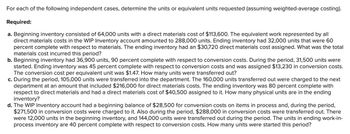
FINANCIAL ACCOUNTING
10th Edition
ISBN: 9781259964947
Author: Libby
Publisher: MCG
expand_more
expand_more
format_list_bulleted
Concept explainers
Question

Transcribed Image Text:For each of the following independent cases, determine the units or equivalent units requested (assuming weighted-average costing).
Required:
a. Beginning inventory consisted of 64,000 units with a direct materials cost of $113,600. The equivalent work represented by all
direct materials costs in the WIP Inventory account amounted to 288,000 units. Ending inventory had 32,000 units that were 60
percent complete with respect to materials. The ending inventory had an $30,720 direct materials cost assigned. What was the total
materials cost incurred this period?
b. Beginning inventory had 36,900 units, 90 percent complete with respect to conversion costs. During the period, 31,500 units were
started. Ending inventory was 45 percent complete with respect to conversion costs and was assigned $13,230 in conversion costs.
The conversion cost per equivalent unit was $1.47. How many units were transferred out?
c. During the period, 105,000 units were transferred into the department. The 160,000 units transferred out were charged to the next
department at an amount that included $216,000 for direct materials costs. The ending inventory was 80 percent complete with
respect to direct materials and had a direct materials cost of $40,500 assigned to it. How many physical units are in the ending
inventory?
d. The WIP Inventory account had a beginning balance of $28,500 for conversion costs on items in process and, during the period,
$271,500 in conversion costs were charged to it. Also during the period, $288,000 in conversion costs were transferred out. There
were 12,000 units in the beginning inventory, and 144,000 units were transferred out during the period. The units in ending work-in-
process inventory are 40 percent complete with respect to conversion costs. How many units were started this period?
Expert Solution
This question has been solved!
Explore an expertly crafted, step-by-step solution for a thorough understanding of key concepts.
This is a popular solution
Trending nowThis is a popular solution!
Step by stepSolved in 3 steps

Knowledge Booster
Learn more about
Need a deep-dive on the concept behind this application? Look no further. Learn more about this topic, accounting and related others by exploring similar questions and additional content below.Similar questions
- How is conversion costs per equivalent unit calculated?arrow_forwardDescribe income statement under variable costing.arrow_forwardWhich type of income statements, Contribution Format or Traditional Format should be used to identify relevant costs? Please provide explanation for your answer. Then provide an example including two income statements based on absorption and variable costing, respectively, to support your explanation.arrow_forward
arrow_back_ios
arrow_forward_ios
Recommended textbooks for you

 AccountingAccountingISBN:9781337272094Author:WARREN, Carl S., Reeve, James M., Duchac, Jonathan E.Publisher:Cengage Learning,
AccountingAccountingISBN:9781337272094Author:WARREN, Carl S., Reeve, James M., Duchac, Jonathan E.Publisher:Cengage Learning, Accounting Information SystemsAccountingISBN:9781337619202Author:Hall, James A.Publisher:Cengage Learning,
Accounting Information SystemsAccountingISBN:9781337619202Author:Hall, James A.Publisher:Cengage Learning, Horngren's Cost Accounting: A Managerial Emphasis...AccountingISBN:9780134475585Author:Srikant M. Datar, Madhav V. RajanPublisher:PEARSON
Horngren's Cost Accounting: A Managerial Emphasis...AccountingISBN:9780134475585Author:Srikant M. Datar, Madhav V. RajanPublisher:PEARSON Intermediate AccountingAccountingISBN:9781259722660Author:J. David Spiceland, Mark W. Nelson, Wayne M ThomasPublisher:McGraw-Hill Education
Intermediate AccountingAccountingISBN:9781259722660Author:J. David Spiceland, Mark W. Nelson, Wayne M ThomasPublisher:McGraw-Hill Education Financial and Managerial AccountingAccountingISBN:9781259726705Author:John J Wild, Ken W. Shaw, Barbara Chiappetta Fundamental Accounting PrinciplesPublisher:McGraw-Hill Education
Financial and Managerial AccountingAccountingISBN:9781259726705Author:John J Wild, Ken W. Shaw, Barbara Chiappetta Fundamental Accounting PrinciplesPublisher:McGraw-Hill Education


Accounting
Accounting
ISBN:9781337272094
Author:WARREN, Carl S., Reeve, James M., Duchac, Jonathan E.
Publisher:Cengage Learning,

Accounting Information Systems
Accounting
ISBN:9781337619202
Author:Hall, James A.
Publisher:Cengage Learning,

Horngren's Cost Accounting: A Managerial Emphasis...
Accounting
ISBN:9780134475585
Author:Srikant M. Datar, Madhav V. Rajan
Publisher:PEARSON

Intermediate Accounting
Accounting
ISBN:9781259722660
Author:J. David Spiceland, Mark W. Nelson, Wayne M Thomas
Publisher:McGraw-Hill Education

Financial and Managerial Accounting
Accounting
ISBN:9781259726705
Author:John J Wild, Ken W. Shaw, Barbara Chiappetta Fundamental Accounting Principles
Publisher:McGraw-Hill Education